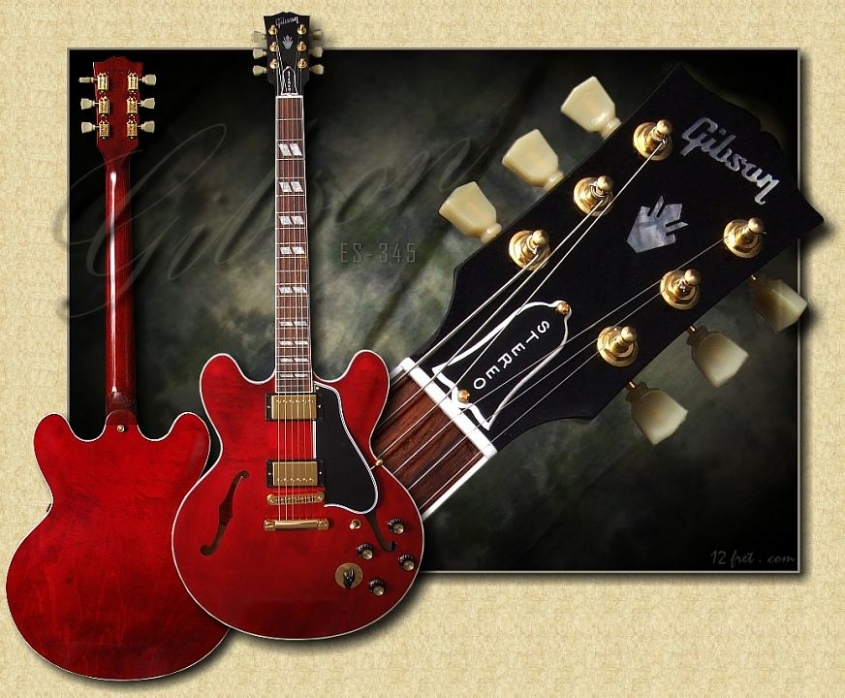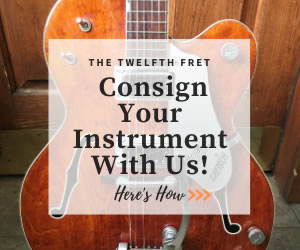The year 1958 was a pivotal point in the evolution of the electric guitar for the Gibson company. Old models were changed and many innovative designs were introduced at the end of the this decade and the beginning of the next. The avante garde Flying V and Explorer were shaking off Gibson’s reputation as a conservative and traditional builder of instruments. Coincidentally the very first V’s were shipped on the same day as the first production run of the new ES-335T models.
Gibson was often just ahead of the competition in design changes, but they were truly inventing a new kind of instrument with the introduction of their double cutaway thinline electrics. The double cutaway design was almost immediately copied by the Fred Gretsch Company (redesigned Chet Atkins) as well as by Guild Guitars (Starfire series). The most important design innovation by far however was the semi-solid construction. The solid block of wood inside the hollow body gave both the sustain of a solidbody with the appearance and feel of a hollowbody. Up until 1958, Gibson guitar necks joined at the 14th fret. This new thinline series with it’s double cutaway had a 19 fret neck joint that gave unprecedented ease of access to the upper registers.
The new ES-335T was an instant success and spawned a line of similar instruments with slightly different features. The first of these was the ES-355 which was essentially a 335 with the aesthetics of a Les Paul Custom i.e.. multi-ply trim, an ebony fingerboard with block pearl markers, gold plated hardware and 5 piece split diamond peghead motif.
The next incarnation of the thinline introduced by Gibson brought back the concept of a stereo guitar that Gretsch had experimented with in the late 40’s (Project-O-Sonic). Rather than splitting the treble and bass strings into a stereo image like Gretsch, Gibson took the simpler solution of splitting the neck pickup from the bridge pickup with the use of a special “Y” cable into a newly designed Gibson GA-88S stereo amplifier. The new stereo guitar was also outfitted with a Vari-Tone circuit which provided 6 preset tones. The new stereo guitar also sported gold plated hardware and split parallelogram fingerboard inlays. This new instrument was introduced in the April 1959 issue of the Gazette and dubbed the ES-345 (sold for $345.00 in sunburst finish). Since its debut in the late ’50s, this classic design has been seen on stage by everyone from Dicky Betts to Chuck Berry to Elvin Bishop.
The new instrument that I’m reviewing this morning is a recreation of the early “long-guard” ES-345, and features a stunning transparent wine red finish, a very fast feeling low elliptical neck profile and a veritable rainbow of tones via the passive Varitone circuit and independent volume and tone controls!
Thanks to A.R. Duchossoir for his invaluable documentation of Gibson guitars in the book “Gibson, The Classic Years”. For anyone interested in Gibson electric guitars, this book is the definitive work on this subject.
Specifications
* 1 11/16″ wide bone nut
* bound rosewood fingerboard
* split parallelogram inlays
* gold plated Gibson Deluxe tuners with plastic tulip buttons
* medium/low elliptical neck profile
* 16″ thinline double cutaway body
* full length internal sustain block
* bound pickguard
* volume and tone controls for each pickup
* output jack for each pickup (stereo or mono option)
* reflector-top knobs
* Varitone circuit with chicken-head knob
* gold plated pickup covers and hardware
* transparent Wine stain under gloss lacquer finish
* Gibson hardshell case

